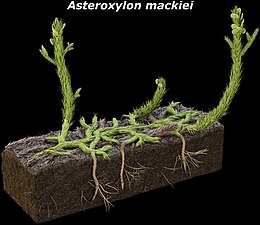Asteroxylon( "star-shaped xylem" ) is anextinctgenus of vascular plants of the DivisionLycopodiophytaknown from anatomically preserved specimens described from the famousEarly DevonianRhynie chertandWindyfield chertinAberdeenshire,Scotland.[1][2]Asteroxylonis considered a basal member of theLycopsida.[3]
| Asteroxylon Temporal range:
| |
|---|---|

| |
| Life restoration | |
| Scientific classification | |
| Kingdom: | Plantae |
| Clade: | Tracheophytes |
| Clade: | Lycophytes |
| Order: | †Drepanophycales |
| Family: | †Asteroxylaceae Kidston & Lang |
| Genus: | †Asteroxylon Kidston & Lang 1920 |
| Type species | |
| Asteroxylon mackiei Kidston & Lang
| |
Description
editAsteroxylonis a genus of terrestrialvascular plantwhich flourished in the EarlyDevonianperiod. This plant consisted of aerial, isotomously and anisotomously branching stems that reached 12 mm in diameter and 40 cm in length.[4]The possibly procumbent aerial stems arose from a leaf-less rhizome which bore smaller-diameter, positively geotropic root-like branches.[4]The rhizomes, which represent an independent origin of roots,[5]reached a depth of up to 20 cm below the surface.[6]A 407 million-year-old fossil from theRhynie chertshows the roots formed through a modified version of a mechanism called“dichotomous branching”,where one of the branches that formed from a shoot-like axis buried into the soil. This method of root formation no longer exists.[7]The xylem or conducting tissue at the center of the aerial stems is distinctly star-shaped in cross-section and has been considered an earlyactinosteleor an "Asteroxylon-type "protostele.[8]Thetracheidsare of the primitive annular or helical type (so-called G-type).[9]"Leaves" – not true leaves, but protrusions – were of the form of unbranched strap-shaped enations up to 5 mm long; a single vascular trace branched from the main bundle in the centre of the stem to terminate at the base of each enation.[3][8]Enations and axes borestomata,indicating that their tissues were capable of photosynthesis.[10]
"Sporangia, consisting of two kidney-shaped valves, are interspersed among the nonvascularized leaflike appendages and attached to the axis with a short pedicel. The sporangia are curved and lie close to the axis."[8][11]Fertile regions of the axes alternate with sterile regions, suggesting periodic episodes of fertility.[8]
Asteroxylondiffers from other similar Early Devonian lycopsids such asDrepanophycusandBaragwanathiain that the singular vascular leaf trace in these latter plants extends into the leaf.[3]The leaves ofDrepanophycusandBaragwanathiaare therefore considered to be truemicrophyllsor, alternatively, small leaves.[12]
Species
editThetype speciesisAsteroxylon mackiei.One other species has been described,Asteroxylon elberfeldense,[13]but this is now considered to be generically distinct and assigned toThursophyton.[9]A fossil originally named asAsteroxylon setchelliiis now considered to be a fern, and is known asStenokoleos setchellii.
Taxonomy
editA 2021 reanalysis found thatAsteroxylonwas more closely related to crown lycophytes than the more basalzosterophyllsandNothia.[14]
See also
editReferences
edit- ^Kidston, R.; Lang, W. H. (1920)."On Old Red Sandstone Plants showing Structure, from the Rhynie Chert Bed, Aberdeenshire. Part III.Asteroxylon Mackiei,Kidston and Lang ".Transactions of the Royal Society of Edinburgh.52(3):643–680.doi:10.1017/S0080456800004506.S2CID131282834.
- ^Rice, C. M.; Ashcroft, W. A.; Batten, D. J.; Boyce, A. J.; Caulfield, J. B. D.; Fallick, A. E.; Hole, M. J.; Jones, E.; Pearson, M. J.; Rogers, G.; Saxton, J. M.; Stuart, F. M.; Trewin, N. H.; Turner, G.; et al. (1995). "A Devonian auriferous hot spring system, Rhynie, Scotland".Journal of the Geological Society, London.152(2):229–250.Bibcode:1995JGSoc.152..229R.doi:10.1144/gsjgs.152.2.0229.S2CID128977213.
- ^abcHao, Shougang; Xue, Jinzhuang (2013).The Early Devonian Posongchong Flora of Yunnan - A Contribution to an Understanding of the Evolution and Early Diversification of Vascular Plants.Beijing: Science Press. pp.244–245.ISBN978-7-03-036616-0.
- ^abStrullu-Derrien, Christine; Wawrzyniak, Zuzanna; Goral, Tomasz; Kenrick, Paul (2015)."Fungal colonization of the rooting system of the early land plantAsteroxylon mackieifrom the 407-Myr-old Rhynie Chert (Scotland, UK) ".Botanical Journal of the Linnean Society.179(1):201–213.doi:10.1111/boj.12307.
- ^Hetherington, Alexander J.; Dolan, Liam (2018)."Stepwise and independent origins of roots among land plants".Nature.561(7722):235–238.Bibcode:2018Natur.561..235H.doi:10.1038/s41586-018-0445-z.PMC6175059.PMID30135586.
- ^Smoot, E.L.; Jansen, R.K.; Taylor, T.N. (1981). "A Phylogenetic Analysis of the Land Plants: A Botanical Commentary".Taxon.30(1):65–67.doi:10.2307/1219392.JSTOR1219392.
- ^400-Million-Year-Old Fossils Reveal How the First Roots Evolved
- ^abcdKerp, Hans; Wellman, Charles H.; Krings, Michael; Kearney, Patricia; Hass, Hagen (2013). "Reproductive organs and in situ spores ofAsteroxylon mackieiKidston & Lang, the most complex plant from the lower Devonian Rhynie chert ".International Journal of Plant Sciences.174(3):293–308.doi:10.1086/668613.S2CID84542464.
- ^abKenrick, Paul & Crane, Peter R. (1997).The Origin and Early Diversification of Land Plants: A Cladistic Study.Washington, D.C.: Smithsonian Institution Press.ISBN978-1-56098-730-7.
- ^Wilson, Jonathon P.; Fischer, Woodward W. (2011)."Hydraulics ofAsteroxylon mackei,an early Devonian vascular plant, and the early evolution of water transport tissue in terrestrial plants ".Geobiology.9(2):121–130.Bibcode:2011Gbio....9..121W.doi:10.1111/j.1472-4669.2010.00269.x.PMID21244621.
- ^In their original description, Kidston & Lang thought that some unconnected sporangial branches, similar to those ofrhyniophytoids,possibly belonged toAsteroxylon,and in spite of the lack of certainty, many subsequent authors constructed suprageneric taxonomies based on this assumption. The true nature ofAsteroxylonsporangia, and of these unconnected sporangia (which were found to belong toNothia aphylla) were later shown by:Lyon, A.G. (1964). "Probable Fertile Region of Asteroxylon mackiei K. and L.".Nature.203(4949):1082–1083.Bibcode:1964Natur.203.1082L.doi:10.1038/2031082b0.S2CID4292879..
- ^Tomescu, Alexandru M.F. (2009). "Megaphylls, microphylls and the evolution of leaf development".Trends in Plant Science.14(1):5–12.doi:10.1016/j.tplants.2008.10.008.PMID19070531.
- ^Fairon, M. (1967). "Asteroxylon elberfeldense Kräusel et Weyland porte-t-il des axes terminaux du typeHostimella hostimensisPotonié et Bernard ".Annales de la Société Géologique de Belgique.10:1–30.
- ^Hetherington, Alexander J; Bridson, Siobhán L; Lee Jones, Anna; Hass, Hagen; Kerp, Hans; Dolan, Liam (2021-08-24)."An evidence-based 3D reconstruction of Asteroxylon mackiei, the most complex plant preserved from the Rhynie chert".eLife.10:e69447.doi:10.7554/eLife.69447.ISSN2050-084X.PMC8384418.PMID34425940.